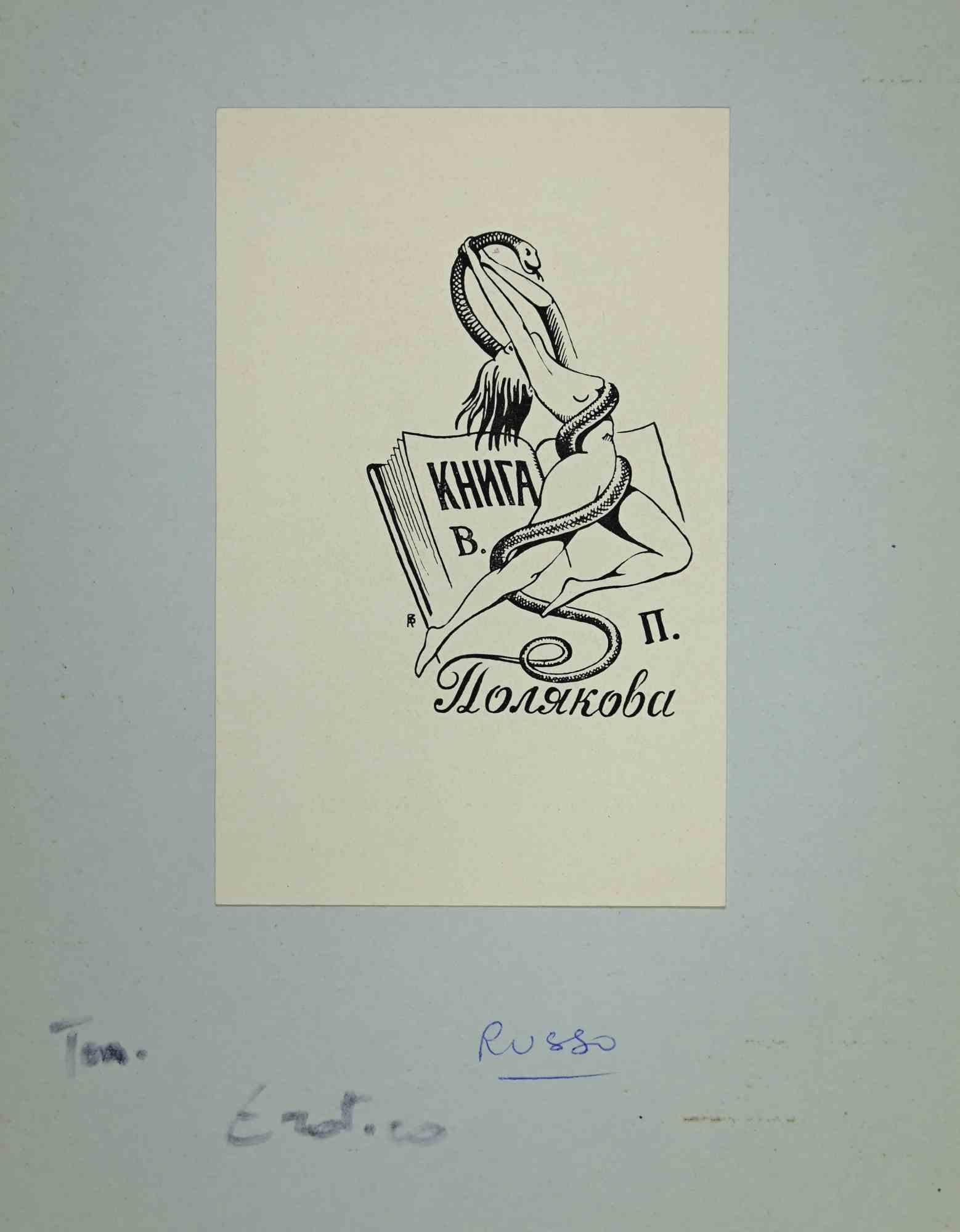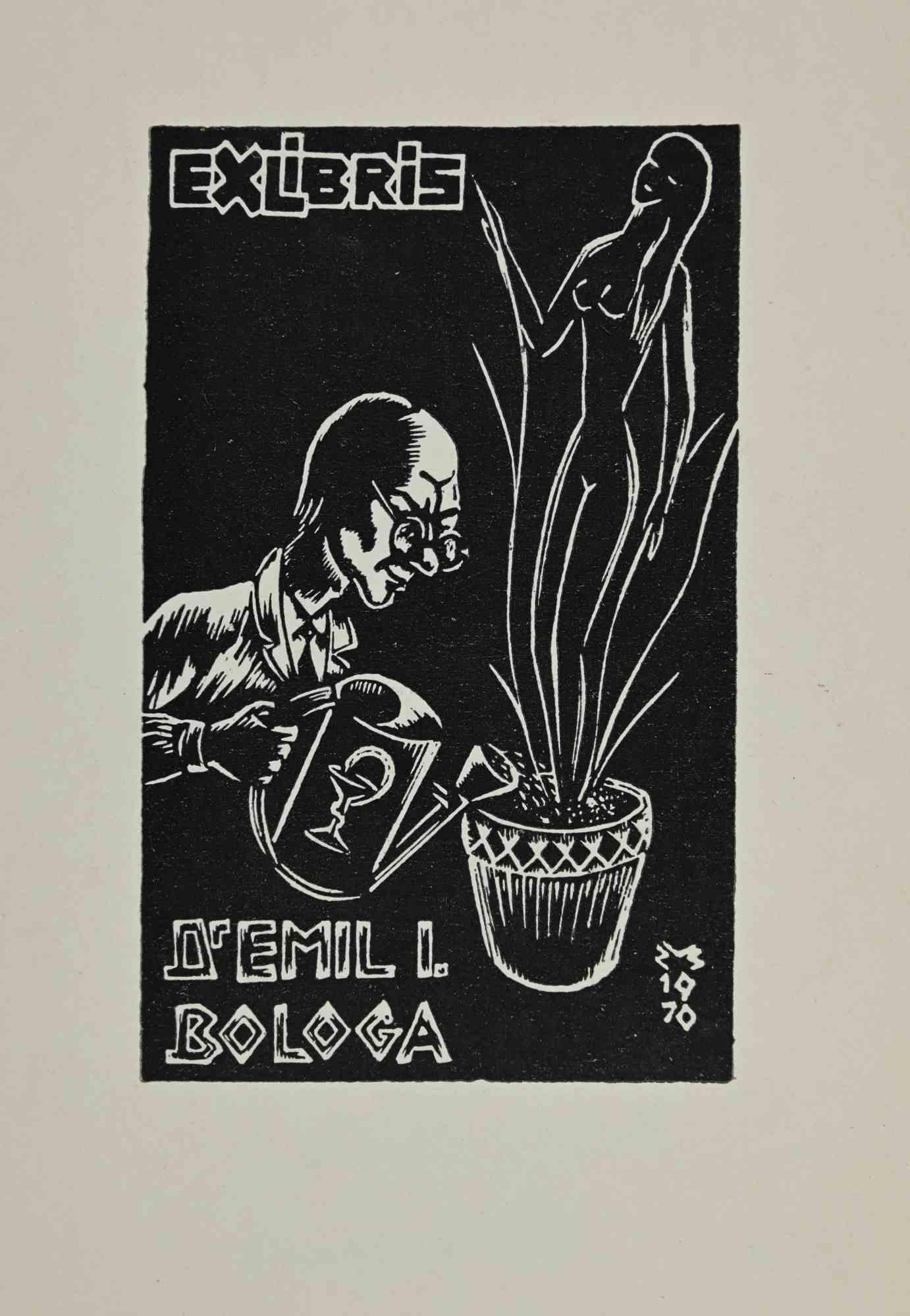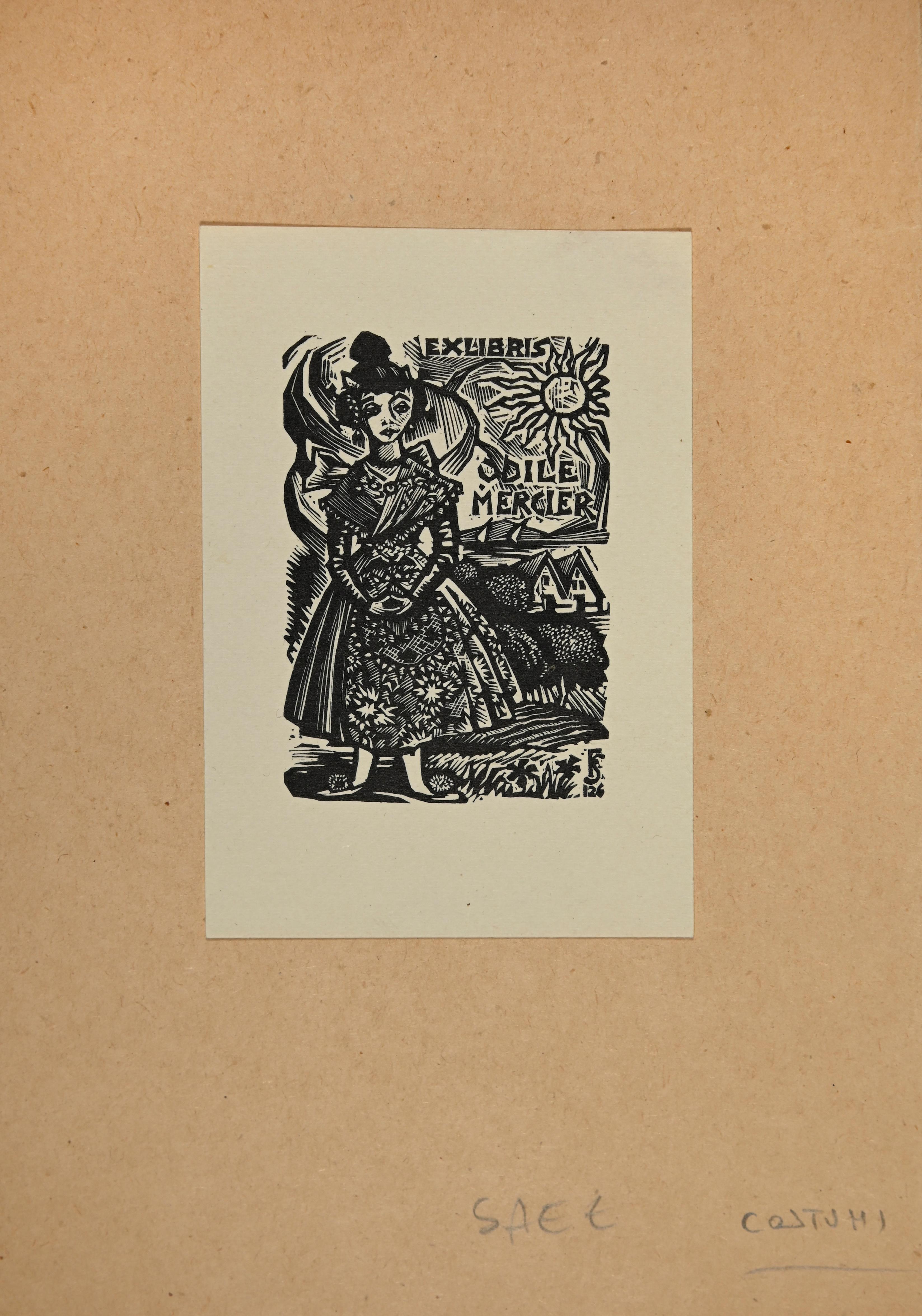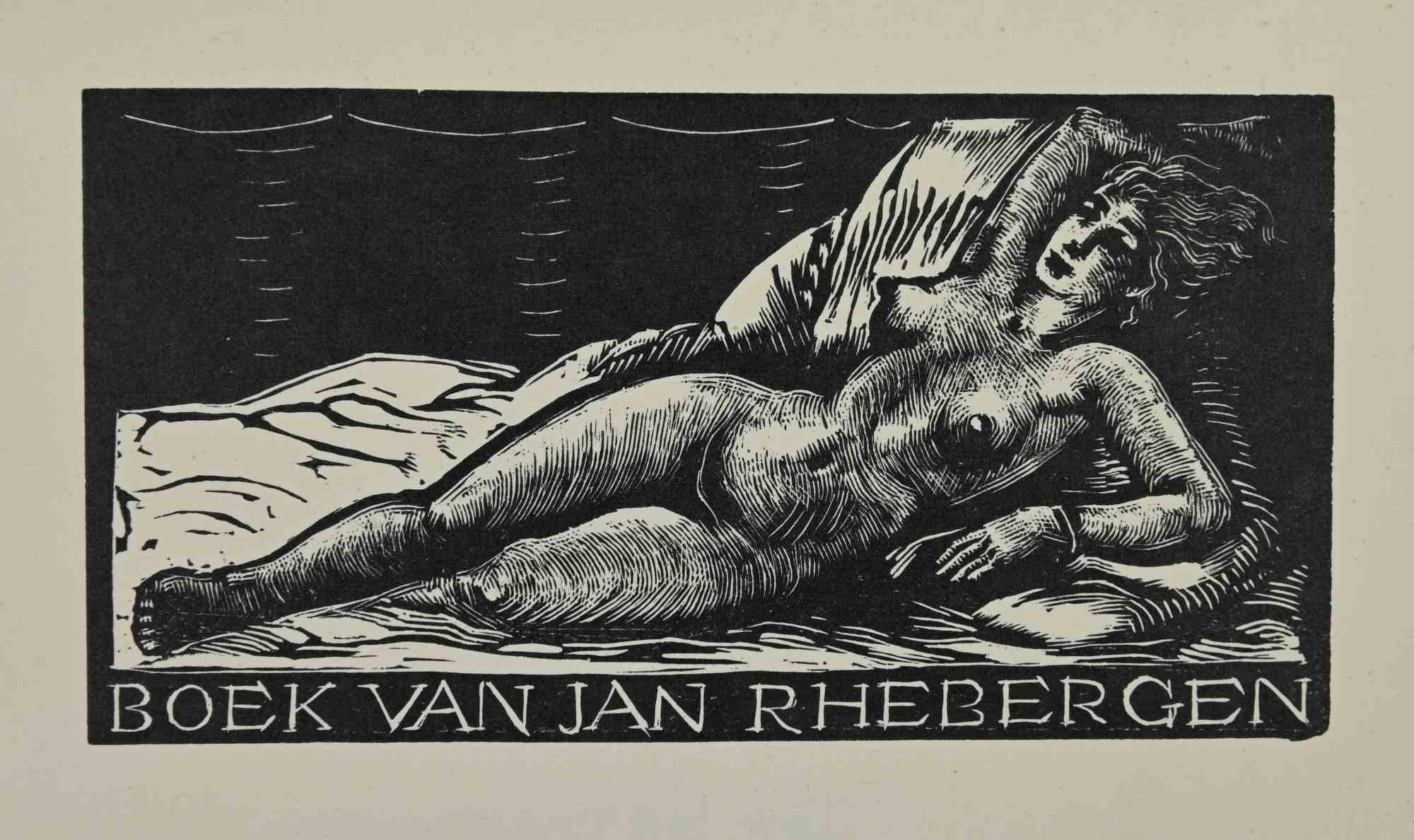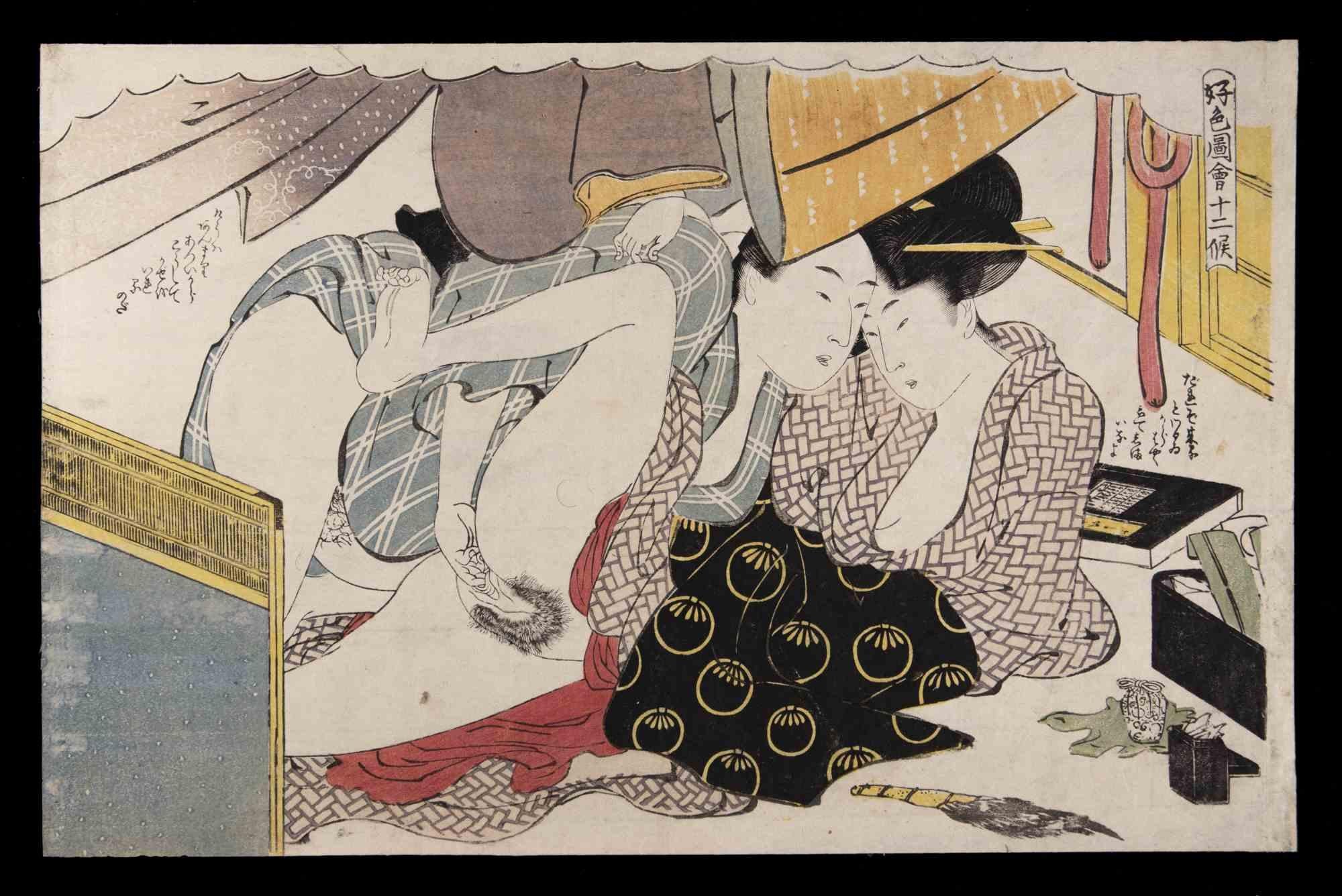Items Similar to At New York (Self Portrait)
Want more images or videos?
Request additional images or videos from the seller
1 of 7
Shiko MunakataAt New York (Self Portrait)1961
1961
About the Item
At New York (Self Portrait)
Woodcut, 1961
Unsigned (as issued)
From: The "Way" of the Woodcut, three woodcuts, 1961
Publisher: Pratt Adlib Press, Brooklyn, New York,1961
Printer: James Lanier at the Press of Igal Roodenko
Edition: 1500 books
Public Collections: MOMA
Library of Congress
Toledo Museum of Art
Condition: Excellent
Image/Sheet size: 12 x 8 1/4 inches
MUNAKATA, SHIKO (1903 - 1975 )
Born in Aomori prefecture, Shiko Munakata is a woodblock print artist best known for his black and white prints and his expressive, sketch-like lines. A self-taught artist, he began his career in oil painting, organizing the Seikokai (Blue Light Group) and exhibiting at Hakujitsukai, Bunten and Teiten. Shiko Munakata changed course in 1926 upon seeing a woodblock print by Sumio Kawakami. After brief instruction from Un’ichi Hiratsuka in 1928, Munakata became active in the woodblock printmaking community: he belonged to both Kokugakai (1932-1953) and Nihon Hanga Kyokai (1932-1938), and contributed to many Sosaku Hanga publications. Around 1936, he garnered the support of Soetsu Yamagai and other leaders of the folk art movement. Shiko Munakata’s work began to heavily feature Buddhist imagery the following year. During the bombing of Tokyo in 1945, he escaped to Toyama prefecture. Shiko Manukata continued woodblock printmaking and received first prize in international exhibitions held in Lugano (1952), Sao Paulo (1955) and Venice (1956). Visiting the United States in 1959, Munakata spent a year exhibiting his work throughout the country. Horinji Temple in Kyoto bestowed him with the honorary rank of “Hokkyo” upon his return to Japan. In 1962, he received the rank of “Hogan” from Nisseki Temple in Toyama prefecture. Shiko Munakata’s accolades continued through the end of the decade, including the Medal of Honor (1963), the Asahi Shimbun culture prize (1965), and the Order of Cultural Merit (1970).
Courtesy Ronin
Munakata 1959 Buddhis triadMunakata's prints have a distinctive spontaneity and spiritual energy. He saw himself as a temporary medium through which the design, not really his own, could be revealed. As a result, unlike Onchi Kôshirô and other artists of the sôsaku hanga (creative print: 創作版画) movement who advocated self-expression in their printmaking, Munakata disclaimed individual responsibility as an artist. For him, artistic creation was only one of many manifestations of nature's force and beauty, which is inherent in the woodblock. In Munakata's words, "The essence of hanga lies in the fact that one must give in to the ways of the board ... there is a power in the board, and one cannot force the tool against that power."
Munakata's works are in numerous private collections and in public institutions, including the Art Gallery of New South Wales; Art Institute of Chicago; Asian Art Museum, San Francisco; British Museum, London; Brooklyn Museum, New York; Carnegie Museum of Art, Pittsburgh; Cincinnati Art Museum; Detroit Institute of Art; Fine Art Museums of San Francisco; Harvard Art Museums; Honolulu Museum of Art; Japan Folk Art Museum, Tokyo; Los Angeles County Museum of Art;Metropolitan Museum of Art, New York; Minneapolis Museum of Art; Munakata Shikô Memorial Museum of Art; Museum of Fine Arts, Boston; Museum of Modern Art, New York; Museum of Modern Art, Tokyo; National Museum of Asian Art (Smithsonian), Washington, D.C.; National Museum of Modern Art, Kyoto; National Museum of Modern Art, Tokyo; Philadelphia Museum of Art; and Rijksmuseum, Amsterdam
Courtesy: Viewing Japanese Prints
- Creator:Shiko Munakata (1903 - 1972, Japanese)
- Creation Year:1961
- Dimensions:Height: 12 in (30.48 cm)Width: 8.25 in (20.96 cm)
- Medium:
- Movement & Style:
- Period:
- Condition:
- Gallery Location:Fairlawn, OH
- Reference Number:
About the Seller
5.0
Recognized Seller
These prestigious sellers are industry leaders and represent the highest echelon for item quality and design.
Platinum Seller
These expertly vetted sellers are 1stDibs' most experienced sellers and are rated highest by our customers.
Established in 1978
1stDibs seller since 2013
718 sales on 1stDibs
Typical response time: 1 hour
Associations
International Fine Print Dealers Association
- ShippingRetrieving quote...Ships From: Akron, OH
- Return PolicyA return for this item may be initiated within 10 days of delivery.
More From This SellerView All
- No Footprints Show, Where the Flowers Grow DeepBy Shiko MunakataLocated in Fairlawn, OHNo Footprints Show, Where the Flowers Grow Deep Woodcut, 1961 Unsigned (as isssued) From: The "Way" of the Woodcut, three woodcuts, 1961 Publisher: Pratt Adlib Press, Brooklyn, New Y...Category
1960s Modern Figurative Prints
MaterialsWoodcut
- The Child Plants an Oak Tree in the GardenBy Shiko MunakataLocated in Fairlawn, OHThe Child Plants an Oak Tree in the Garden Woodcut, 1961 Unsigned (as issued) From: The "Way" of the Woodcut, three woodcuts, 1961 Publisher: Pratt Adlib Press, Brooklyn, New York,19...Category
1960s Modern Figurative Prints
MaterialsWoodcut
- Xylon 21 Naoko Matsubara USALocated in Fairlawn, OHXylon 21 Naoko Matsubara USA Woodcuts, two which are printed in color, 1970 2 of the 5 woodcuts signed in pencil (see photos) Five original woodcuts, two of which are signed in pencil With introduction entitled Honest Pinetree by Frizt Eichenberg The images are: The Quaker’s Meeting, double page woodcut cover on grey/green paper, signed in pencil, with usual centerfold Publisher: Sekton Schweiz de Xylon, Zurich Date: August 1970 Edition: 500 Sylvan Snow, double page woodcut (with usual centerfold), signed in pencil, dedicated and dated, depicting a forest Verso: Dragon, double page woodcut, with usual centerfold, depicting a dragon Indian Dancer, double page woodcut in black and green (with usual centerfold), depicting dancer Verso: Chinese Dancer. woodcut in red, depicting a dancer Condition: Very good, usual handling issues for paper portfolio Centerfolds as issued Signle filio: 19 3/8 x 13 1/2 inches Double folio: 19 3/8 x 27 inches Publisher: Sekton Schweiz de Xylon, Zurich Date: August 1970 Edition: 500 Provenance: Amity Art Foundation, Inc. A rare dedicated example with a dedication in pencil “For Frank” and dated 1970 Note: Matsubara graduated from the Kyoto University of Applied Arts in 1960. She then pursued an MFA in the School of Fine Arts at the Carnegie Mellon University in Pittsburgh on a Fulbright Travel Grant, and since then has traveled extensively and taught at the Pratt Institute in Brooklyn—a rare distinction for a Japanese woman. She also studied one year at the Royal College of Art, London. Currently she lives and works in Oakville, Canada. Naoko Matsubara’s style is influenced by her teacher Munakata Shiko (1903–1975), who worked in the mingei (folk art) tradition. Her works are part of the collections of many museums around the world such as the Philadelphia Museum of Art, the Chicago Art Institute, the Royal Ontario Museum, the Albertina in Vienna, the British Museum in London, the Kyoto National Museum of Modern Art, the Museum of Fine Arts, Boston, the Tokyo National Museum of Modern Art, the Smithsonian Institution and the Library of Congress in Washington, the Hamburg Museum of Arts and Crafts, the Haifa Museum in Israel and the Art Gallery of New South Wales in Sydney. She was made a member of the Royal Canadian Academy of Arts. (Courtesy of Wikipedia) Naoko Matsubara (1937 - ) Matsubara Naoko (松原直子) was born in 1937 on Shikoku Island into an old Shinto family, and grew up in Kyoto, where her father was a senior priest. She was educated at the Kyoto Academy of Fine Art (BFA, 1960); and was a Fulbright Scholar at what is now Carnegie Mellon University, Pittsburgh (MFA, 1962). She was also a Special Invited Student at the Royal College of Art in London (1962). After travelling extensively in Europe and Asia, Naoko Matsubara returned to Japan for two years, before being lured back to the United States. There she worked as personal assistant to the late Prof. Fritz Eichenberg, and also taught at the Pratt Institute of Graphic Art in New York, as well as at the University of Rhode Island. Subsequently she lived in Cambridge, Mass. In 1972 Naoko Matsubara moved to Canada, and now lives in Oakville, Ontario. She has continued to be extremely active as an artist: locally, nationally and internationally. Since 1960 she has had some 75 solo exhibitions, in the USA, Canada, Japan, England, Ireland, Germany, Austria, Switzerland, Holland and Mexico. She has also participated in numerous group exhibitions. Public collections owning work by Naoko Matsubara include: Albertina, Vienna; Art Institute of Chicago; British Museum; Carnegie Institute; Museum für Kunst und Gewerbe, Hamburg; Museum of Fine Arts, Boston; Philadelphia Museum of Art; Cincinnati Art Museum; Detroit Institute of Art; Fogg Art Museum, Harvard University; Haifa Museum, Israel; Kyoto National Museum of Modern Art; Royal Ontario Museum; The White House, Washington DC; Tokyo National Museum of Modern Art; Yale University Art Gallery. Naoko Matsubara has published some 20 books and portfolios of her work, including most recently Tibetan Sky (Calgary: Bayeux Arts Publishers, 1997; Preface by the Dalai Lama); Tokonoma (Bath, England: Old School Press, 1999); and Konjaku monogatari (Tokyo: ALIS, 2002). Her work also includes a large mural and donor pillar for the new YMCA building in Oakville, Ontario (2003); mixed-media screens; and paintings. In 2005, the Royal Ontario Museum commissioned two large works from Naoko Matsubara for the Museum's Bloor Street window case. The artist generously donated a third work, Emerald Summer (2006). The three works (each 195 cm. high by 95 cm. wide) will be rotated at regular intervals into the outside window. This is the first commissioned artwork to be displayed on the Museum’s Bloor Street Plaza. Recent major exhibitions have been in Tokyo, Kyoto, Indiana, and Toronto (Royal Ontario Museum). Further exhibitions are currently being planned in Seattle and Tokyo; new books in process include In Praise of Hands. She also continues to travel widely; is frequently invited to speak about her work; and also publishes essays, in both English and Japanese. Naoko Matsubara’s work has been the subject of countless articles and reviews; documentary films (including two from the Canadian Broadcasting Corporation); and several book-length publications: notably Mokuhan: The Woodcuts of Munakata and Matsubara (text by Joan Stanley-Baker; Victoria, BC: Art Gallery of Greater Victoria, 1976); Naoko Matsubara: Development of Artistic Style and Technique (text by Barbara Woodworth; MFA thesis, Harvard University, 1985);.and Tree Spirit...Category
1970s Abstract Figurative Prints
MaterialsWoodcut
- WO RO SI IA ZIN Russian Soldier with His FamilyLocated in Fairlawn, OHWO RO SI IA ZIN Russian Soldier with His Family Color woodcut, 1861 2nd month Signed upper left (see photo) Titled upper right in black cartouche (see photo) Format: oban Style: Yokohama-e Publisherr: Sagamiya Tokichi (Marks #435) active 1955-1866 Metropolitan Museum of Art in New York, has an impression of this image RARE Condition: with usual aging Image size: 13 7/8 x 9 3/8 inches Rebecca Salter in her Japanese Popular Prints... on page 18 gives a different take on the situation that Yoshifuji found himself in. "A giant of the period, however, was Utagawa Kuniyoshi (1797-861). Although best known for warrior prints which reflected the militaristic undercurrents of the time, he was also responsible for some of the most light-heartend and humorous works in this book. His followers in the Utagawa school, Utagawa Yoshitsuya...Category
1860s Other Art Style Figurative Prints
MaterialsWoodcut
- Beauty on a Veranda with Fan and MirrorBy Suzuki (Hozumi) HarunobuLocated in Fairlawn, OHSigned: Harunobu ga Series: Series: Eight Fashionable Parlor Views (Furyu zashiki hakkei)? Format Japanese: chuban Provenance: Private Collection, Philadelphia Collection of McCleaf ...Category
Mid-18th Century Edo Prints and Multiples
MaterialsWoodcut
- The Dutiful Youth of Mino Province Collecting Wood to Warm His Old FatherBy Utagawa KuniyoshiLocated in Fairlawn, OHThe Dutiful Youth of Mino Province Collecting Wood to Warm His Old Father Color woodcut, c. 1842-43 Signed and sealed lower right (see photo) From the Series: "Honcho nijushi-ko" (Tw...Category
1840s Other Art Style Figurative Prints
MaterialsWoodcut
You May Also Like
- Shunga - Woodcut by Katsukawa Schuncho - Mid-18th CenturyBy Katsukawa ShunshōLocated in Roma, ITShunga is an original modern artwork realized by Katsukawa Schuncho (1726 – 1793) in the half of the 18th Century. Erotic scene from the series "Koshuko zue juni ko". A courtesan with a customer under a kimono stand...Category
Mid-18th Century Modern Portrait Prints
MaterialsPaper, Woodcut
- Ex-Libris - Boek Van Jan Rhebergen - Woodcut - Mid 20th CenturyLocated in Roma, ITEx-Libris - Boek Van Jan Rhebergen is an Artwork realized in Mid 20th Century. Woodcut on paper. Good conditions. The artwork represents a minimalistic, clean design, through prec...Category
Mid-20th Century Modern Figurative Prints
MaterialsWoodcut
- Ex-Libris - Mercier - Woodcut- Mid 20th CenturyLocated in Roma, ITEx-Libris - Mercier is an Artwork realized in Mid 20th Century. Woodcut on paper. Good conditions. The artwork represents a minimalistic, clean design, through preciseness .Category
Mid-20th Century Modern Figurative Prints
MaterialsWoodcut
- Ex-Libris - D'Emil I. Bologa - Woodcut - Mid 20th CenturyLocated in Roma, ITEx-Libris - Mario de Filippis is an Artwork realized in Mid 20th Century. Woodcut on paper. Good conditions. The artwork represents a minimalistic, clean design, through precisene...Category
Mid-20th Century Modern Figurative Prints
MaterialsWoodcut
- Ex-Libris - woodcut - Mid 20th CenturyLocated in Roma, ITEx-Libris is an Artwork realized in Mid 20th Century. Woodcut on paper. Good conditions. The artwork represents a minimalistic, clean design, through preciseness .Category
Mid-20th Century Modern Figurative Prints
MaterialsWoodcut
- Ex-Libris - Reisinger Jeno - woodcut - Mid 20th CenturyLocated in Roma, ITEx-Libris - Reisinger Jeno is an Artwork realized in Mid 20th Century. Woodcut on paper. Good conditions. The artwork represents a minimalistic, clean design, through preciseness.Category
Mid-20th Century Modern Figurative Prints
MaterialsWoodcut
Recently Viewed
View AllMore Ways To Browse
Woodblock Portrait
Japanese Woodblock Beauties
Vintage Japanese Tools
Woodblock Black And White Print
Kyoto Light
Japanese Woodblock Portrait
James Harvard
Japanese Black And White Woodblock Prints
Buddhist Folk Art
Vintage Tool Board
Vintage Tool Organizer
Sosaku Hanga
White Hogan
Ronin Gallery
Munakata Shiko
Used Fencing
Vintage Americana Signs
Michael Roman

